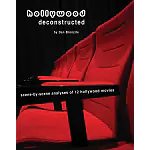How often in life do you meet someone that is flawless? Conversely, how often do you meet someone that does not have a single good bone in their body? Never. It’s impossible. We human beings are very complex creatures and that’s what makes us so fascinating. And that’s also what makes good movie characters so interesting.
We, as an audience, or as a reader, are usually not drawn to flat, two-dimensional characters that do what they say they’ll do and practice what they preach. Most of us try to be good people and do good things but we all have flaws – it’s human nature. Sometimes our own selfishness, jealousy, preconceptions and prejudice creep into our words and actions and it doesn’t make us bad people.. just human.
The same should be applied to the characters we create in our screenplays and novels. These people may inhabit an imaginary world but that world usually reflects our own, even if it is set on another planet, often there is a common thread of humanity that runs through the narrative. If there wasn’t then we would find it extremely hard to identify with anyone or anything and the movie wouldn’t engage us on any level.
So the next time you sit down in front of your computer and fire up your screenwriting software, think about your central characters and their psychological make-up. What makes them tick? What are their hang-ups? Are they coffee addicts? Are they gym freaks? Do any of their hobbies take over their lives to such a degree that they alienate friends and family? Do they have bad habits? Do they lie or cheat? Do they drink or smoke? Do they gamble or steal? It doesn’t have to be a big flaw, even a small flaw can make a character appear more three-dimensional.
The other great thing about introducing flaws, even if they are just for you to know as the writer, is that they give you the opportunity to create comedy and conflict. And if you use these flaws when developing your character arcs they will subtly influence character actions and their dialogue. Sometimes creating a backstory for your character can help when deciding on a flaw because it gives you a sound logical reason for their behaviour and choices.
For instance, say your hero was bullied as a kid. Maybe he was always picked on at the same place, and thus the image of this place was then burned into his/her memory and associated with bad things. The place could be anywhere.. a hot dog stand, a library, a swimming pool. The point is, as an adult (in your movie), this character can then have a hang up about eating fast food, reading books, or going swimming. The hang up could be that he/she comfort eats hot dogs when he/she gets depressed, or throws up if he/she smells fast food. He/she may have a bizarre hatred for book readers and book clubs, or read so much that he/she doesn’t have a social life.
And remember, the same principle can be used in reverse when writing your antagonist or one of his/her henchman. Maybe your baddie kills people without a thought but has a love for flowers or pets. Maybe he/she has a penchant for blades and making people bleed but when he accidentally knocks over a young school girl in his car, he feels bad and takes her to the hosipital and waits by her bedside. It’s all about layers. Obviously, certain genres require an absolute “baddie” but even then it’s far more interesting to shape your characters using many contradictory layers. Make them ambiguous in intent so the audience are constantly reassessing their motives and objectives.




